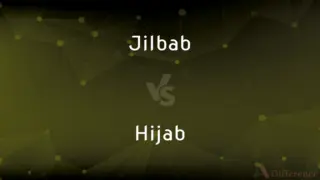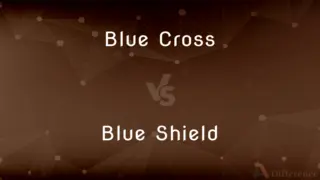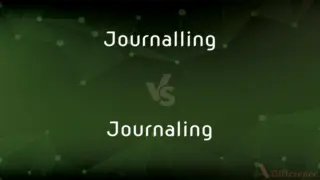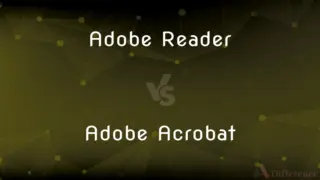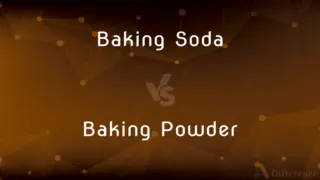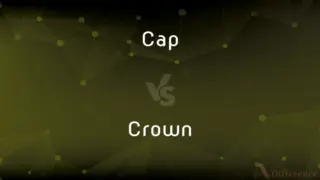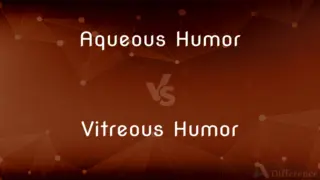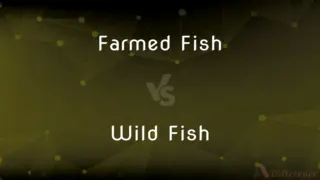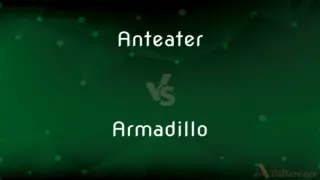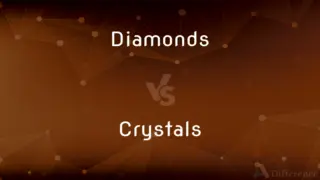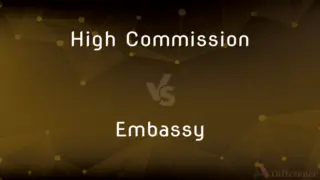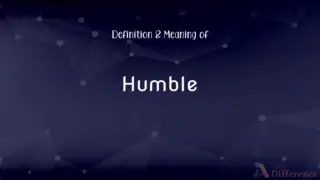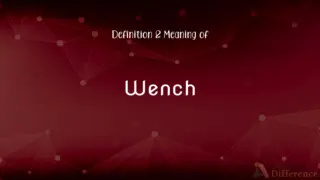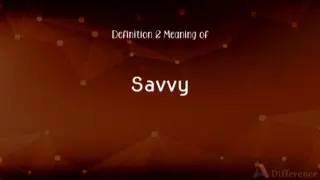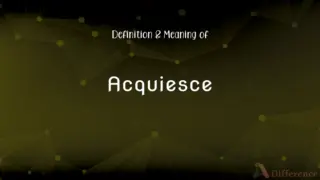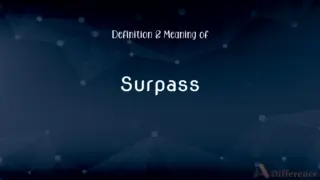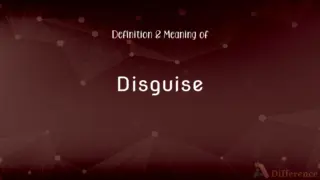Strut vs. Tie — What's the Difference?
By Tayyaba Rehman & Maham Liaqat — Updated on April 16, 2024
Struts provide structural support to resist longitudinal compression, whereas ties withstand tension, connecting parts to prevent spreading.

Difference Between Strut and Tie
Table of Contents
ADVERTISEMENT
Key Differences
A strut is an integral component of various frameworks, primarily functioning to resist compression. It's often used in architecture and engineering to keep structures stable under various loads. On the other hand, a tie serves the opposite purpose, being employed to handle tension. It helps in holding parts of a structure together, ensuring that they do not move apart under stress.
Struts are typically rigid and can be seen in applications such as roof trusses or vehicle suspension systems. They help maintain the integrity of structures by resisting forces that attempt to compress or shorten them. Whereas ties are more flexible, commonly found in applications like bridge cables or the ties in railway tracks, focusing on pulling components together and maintaining alignment and spacing.
The material composition of struts usually includes steel, concrete, or timber, which are materials capable of withstanding significant compressive forces. These materials are chosen for their durability and strength. On the other hand, ties are often made from materials like steel wire, rope, or synthetic fibers, which are excellent at handling tensile stresses without breaking.
Installation of struts involves securing them in a way that they can effectively transfer compressive loads to the foundation or other structural elements. This is crucial in maintaining the stability of structures under load. Conversely, ties are installed to stretch and provide a pulling force that keeps structural elements from diverging, playing a critical role in the tensional integrity of a system.
In maintenance terms, struts require inspection for signs of buckling or failure in compression, which could compromise structural integrity. On the other hand, ties need regular checks for wear and tear, elongation, or corrosion, which could reduce their effectiveness in tension.
ADVERTISEMENT
Comparison Chart
Primary Function
Resists compression
Resists tension
Common Materials
Steel, concrete, timber
Steel wire, rope, synthetic fibers
Typical Uses
Roof trusses, vehicle suspension
Bridge cables, railway track ties
Installation
Secured to bear compressive loads
Stretched to provide tensile strength
Maintenance
Inspect for buckling or compression failure
Check for wear, elongation, corrosion
Compare with Definitions
Strut
A support or piece used in vehicles for suspension.
The mechanic replaced the worn struts to improve the car's ride.
Tie
A long, slender piece used to hold parts together.
The railway tracks are kept aligned with heavy-duty ties.
Strut
A structural component designed to resist longitudinal compression.
The roof's stability is ensured by several steel struts.
Tie
A structural component designed to resist tension and maintain integrity.
The bridge's strength comes from the numerous ties that connect its beams.
Strut
A brace used to stiffen structures against applied loads.
We added struts to the stage design to prevent any collapse.
Tie
A flexible connector made from materials like rope or wire.
We used a synthetic tie to secure the cargo on the truck.
Strut
A rod or bar forming part of a framework.
The artist used struts of various lengths to create his sculptural installation.
Tie
A tension element in building construction.
The architectural design includes several steel ties for aesthetic and functional purposes.
Strut
Any part of a structure intended to resist pressure.
The old barn was reinforced with wooden struts to extend its life.
Tie
An implement for joining or binding things together.
The gardener used ties to secure the plants to their supports.
Strut
A strut is a structural component commonly found in engineering, aeronautics, architecture and anatomy. Struts generally work by resisting longitudinal compression, but they may also serve in tension.
Tie
A rod or beam holding parts of a structure together.
Strut
A rod or bar forming part of a framework and designed to resist compression
A spindly framework of long, slender struts, girders, and bracing wire
A supporting strut
Tie
Attach or fasten with string or similar cord
Her long hair was tied back in a bow
Gabriel tied up his horse
They tied Max to a chair
Strut
A stiff, erect, and apparently arrogant or conceited gait
That old confident strut and swagger has returned
Tie
Restrict or limit (someone) to a particular situation or place
She didn't want to be like her mother, tied to a feckless man
She didn't want to be tied down by a full-time job
Strut
Walk with a stiff, erect, and apparently arrogant or conceited gait
She strutted down the catwalk
Peacocks strut through the grounds
Tie
Connect; link
Self-respect is closely tied up with the esteem in which one is held by one's fellows
Strut
Brace (something) with a strut or struts
The holes were close-boarded and strutted
Tie
Achieve the same score or ranking as another competitor or team
Norman needed a par to tie with Nicklaus
Muir tied the score at 5–5
Strut
To walk with pompous bearing; swagger.
Tie
A piece of string, cord, or similar used for fastening or tying something
He tightened the tie of his robe
Strut
To display in order to impress others. Sometimes used with out
Don't strut out your resume until you have more accomplishments to list.
Tie
A thing that unites or links people
It is important that we keep family ties strong
Strut
To provide (a structure) with a strut or struts.
Tie
A strip of material worn round the collar and tied in a knot at the front with the ends hanging down, typically forming part of a man's smart or formal outfit
His hand went up to his collar and started to loosen his tie
Strut
To brace or separate with a strut.
Tie
A result in a game or other competitive situation in which two or more competitors or teams have the same score or ranking; a draw
There was a tie for first place
Strut
A pompous, self-important gait.
Tie
A sports match between two or more players or teams in which the winners proceed to the next round of the competition
Swindon Town have won themselves a third round tie against Oldham
Strut
A structural element used to brace or strengthen a framework by resisting stress or compression.
Tie
To fasten or secure with or as if with a cord, rope, or strap
Tied the kite to a post.
Tie up a bundle.
Strut
(intransitive) Of a peacock or other fowl: to stand or walk stiffly, with the tail erect and spread out.
Tie
To fasten by drawing together the parts or sides and knotting with strings or laces
Tied her shoes.
Strut
To walk haughtily or proudly with one's head held high.
He strutted about the yard, thinking himself master of all he surveyed.
Tie
To make by fastening ends or parts
Tie a knot.
Strut
To walk across or on (a stage or other place) haughtily or proudly.
Tie
To put a knot or bow in
Tie a neck scarf.
Strut
Often followed by out: to protuberate or stick out due to being full or swollen; to bulge, to swell.
Tie
To confine or restrict as if with cord
Duties that tied him to the office.
Strut
Often followed by out: to cause (something) to bulge, protrude, or swell.
Tie
To equal (an opponent or an opponent's score) in a contest.
Strut
To brace or support (something) by a strut or struts; to hold (something) in place or strengthen by a diagonal, transverse, or upright support.
Tie
To equal an opponent's score in (a contest)
Tied the game with minutes remaining.
Strut
(intransitive) To be attached diagonally or at a slant; also, to be bent at a sharp angle.
Tie
(Music)To join (notes) by a tie.
Strut
A step or walk done stiffly and with the head held high, often due to haughtiness or pride; affected dignity in walking.
Tie
To be fastened or attached
The apron ties at the back.
Strut
(historical) An instrument for adjusting the pleats of a ruff.
Tie
To achieve equal scores in a contest.
Strut
A beam or rod providing support.
Tie
A cord, string, or other means by which something is tied.
Strut
An act of angle]]; specifically, deviation (of the spoke of a wheel) from the normal position.
Tie
A necktie.
Strut
(obsolete) Swelling out due to being full; bulging, protuberant, swollen.
Tie
A beam or rod that joins parts and gives support.
Strut
Drunk, intoxicated; fou.
Tie
One of the timbers or slabs of concrete laid across a railroad bed to support the rails.
Strut
To swell; to bulge out.
The bellying canvas strutted with the gale.
Tie
An equality of scores, votes, or performance in a contest
The election ended in a tie.
Strut
To walk with a lofty, proud gait, and erect head; to walk with affected dignity.
Does he not hold up his head, . . . and strut in his gait?
Tie
A contest so resulting; a draw.
Strut
The act of strutting; a pompous step or walk.
Tie
(Music)A curved line above or below two notes of the same pitch, indicating that the tone is to be sustained for their combined duration.
Strut
In general, any piece of a frame which resists thrust or pressure in the direction of its own length. See Brace, and Illust. of Frame, and Roof.
Tie
A knot; a fastening.
Strut
Any part of a machine or structure, of which the principal function is to hold things apart; a brace subjected to compressive stress; - the opposite of stay, and tie.
Tie
A knot of hair, as at the back of a wig.
Strut
Protuberant.
Tie
A necktie (item of clothing consisting of a strip of cloth tied around the neck). See also bow tie, black tie.
Strut
Struthious.
Tie
A twist tie, a piece of wire embedded in paper, strip of plastic with ratchets, or similar object which is wound around something and tightened.
Strut
A proud stiff pompous gait
Tie
A strong connection between people or groups of people.
The sacred ties of friendship or of duty
The ties of allegiance
Strut
Brace consisting of a bar or rod used to resist longitudinal compression
Tie
(construction) A structural member firmly holding two pieces together.
Ties work to maintain structural integrity in windstorms and earthquakes.
Strut
To walk with a lofty proud gait, often in an attempt to impress others;
He struts around like a rooster in a hen house
Tie
A horizontal wooden or concrete structural member that supports and ties together rails.
Tie
The situation in which two or more participants in a competition are placed equally.
It's two outs in the bottom of the ninth, tie score.
Tie
(cricket) The situation at the end of all innings of a match where both sides have the same total of runs (different from a draw).
Tie
An equalizer, a run, goal, point, etc which causes participants in a competition to be placed equally or have the same score(s).
Tie
A meeting between two players or teams in a competition.
The FA Cup third round tie between Liverpool and Cardiff was their first meeting in the competition since 1957.
Tie
(music) A curved line connecting two notes of the same pitch denoting that they should be played as a single note with the combined length of both notes.
Tie
(statistics) One or more equal values or sets of equal values in the data set.
Tie
(surveying) A bearing and distance between a lot corner or point and a benchmark or iron off site.
Tie
(graph theory) A connection between two vertices.
Tie
A tiewig.
Tie
(transitive) To twist (a string, rope, or the like) around itself securely.
Tie this rope in a knot for me, please.
Tie the rope to this tree.
Tie
(transitive) To form (a knot or the like) in a string or the like.
Tie a knot in this rope for me, please.
Tie
(transitive) To attach or fasten (one thing to another) by string or the like.
Tie him to the tree.
Tie
To secure (something) by string or the like.
Tie your shoes.
Tie
(ambitransitive) To have the same score or position as another in a competition or ordering.
They tied for third place.
They tied the game.
Tie
To have the same score or position as (another) in a competition or ordering.
He tied me for third place.
Tie
(music) To unite (musical notes) with a line or slur in the notation.
Tie
To believe; to credit.
Tie
In the Perl programming language, to extend (a variable) so that standard operations performed upon it invoke custom functionality instead.
Tie
A knot; a fastening.
Tie
A knot of hair, as at the back of a wig.
Tie
An equality in numbers, as of votes, scores, etc., which prevents either party from being victorious; equality in any contest, as a race.
Tie
A beam or rod for holding two parts together; in railways, one of the transverse timbers which support the track and keep it in place.
Tie
A line, usually straight, drawn across the stems of notes, or a curved line written over or under the notes, signifying that they are to be slurred, or closely united in the performance, or that two notes of the same pitch are to be sounded as one; a bind; a ligature.
Tie
Low shoes fastened with lacings.
Tie
To fasten with a band or cord and knot; to bind.
My son, keep thy father's commandment, and forsake not the law of thy mother: bind them continually upon thine heart, and tie them about thy neck.
Tie
To form, as a knot, by interlacing or complicating a cord; also, to interlace, or form a knot in; as, to tie a cord to a tree; to knit; to knot.
Tie
To unite firmly; to fasten; to hold.
In bond of virtuous love together tied.
Tie
To hold or constrain by authority or moral influence, as by knotted cords; to oblige; to constrain; to restrain; to confine.
Not tied to rules of policy, you findRevenge less sweet than a forgiving mind.
Tie
To unite, as notes, by a cross line, or by a curved line, or slur, drawn over or under them.
Tie
To make an equal score with, in a contest; to be even with.
Tie
To make a tie; to make an equal score.
Tie
Neckwear consisting of a long narrow piece of material worn (mostly by men) under a collar and tied in knot at the front;
He stood in front of the mirror tightening his necktie
He wore a vest and tie
Tie
A social or business relationship;
A valuable financial affiliation
He was sorry he had to sever his ties with other members of the team
Many close associations with England
Tie
The finish of a contest in which the score is tied and the winner is undecided;
The game ended in a draw
Their record was 3 wins, 6 losses and a tie
Tie
A horizontal beam used to prevent two other structural members from spreading apart or separating;
He nailed the rafters together with a tie beam
Tie
A fastener that serves to join or link;
The walls are held together with metal links placed in the wet mortar during construction
Tie
Equality of score in a contest
Tie
(music) a slur over two notes of the same pitch; indicates that the note is to be sustained for their combined time value
Tie
One of the cross braces that support the rails on a railway track;
The British call a railroad tie a sleeper
Tie
A cord (or string or ribbon or wire etc.) with which something is tied;
He needed a tie for the packages
Tie
Fasten or secure with a rope, string, or cord;
They tied their victim to the chair
Tie
Finish a game with an equal number of points, goals, etc.;
The teams drew a tie
Tie
Limit or restrict to;
I am tied to UNIX
These big jets are tied to large airports
Tie
Connect, fasten, or put together two or more pieces;
Can you connect the two loudspeakers?
Tie the ropes together
Link arms
Tie
Form a knot or bow in;
Tie a necktie
Tie
Create social or emotional ties;
The grandparents want to bond with the child
Tie
Perform a marriage ceremony;
The minister married us on Saturday
We were wed the following week
The couple got spliced on Hawaii
Tie
Make by tying pieces together;
The fishermen tied their flies
Tie
Unite musical notes by a tie
Common Curiosities
What materials are commonly used to make struts?
Struts are commonly made from materials like steel, concrete, or timber.
What is a typical application of a tie?
Ties are commonly used in bridge cables or as railway track ties.
How do ties differ from struts in their purpose?
Ties are designed to resist tension, unlike struts, which resist compression.
What should be checked during tie maintenance?
Ties should be checked for wear, elongation, and corrosion.
Are struts or ties more susceptible to environmental damage?
Ties, often being exposed and made of materials like wire, are more susceptible to environmental damage.
What are some examples of strut applications in architecture?
Struts are used in applications like roof trusses and support beams.
What is the main function of a strut?
A strut primarily resists compression to maintain structure under loads.
How do the installation requirements differ for struts and ties?
Struts need to be securely installed to handle compressive forces, whereas ties are installed to stretch and handle tensile forces.
How are struts maintained?
Struts require inspections for signs of compression failure or buckling.
What roles do ties play in structural integrity?
Ties help maintain alignment and prevent structural elements from moving apart.
Can ties be made from synthetic materials?
Yes, ties can be made from synthetic fibers which are excellent for resisting tension.
How do the functions of struts and ties complement each other in construction?
In construction, struts prevent structures from collapsing under compression, while ties prevent them from pulling apart.
Can struts be used in vehicle design?
Yes, struts are used in vehicle suspensions to enhance stability and ride.
What is the difference in the flexibility between struts and ties?
Struts are generally rigid, whereas ties are flexible to accommodate tension.
What types of structures benefit most from the use of struts?
Buildings, vehicles, and large-scale sculptures often rely on struts for stability.
Share Your Discovery

Previous Comparison
Story vs. Article
Next Comparison
Heuristic vs. StochasticAuthor Spotlight
Written by
Tayyaba RehmanTayyaba Rehman is a distinguished writer, currently serving as a primary contributor to askdifference.com. As a researcher in semantics and etymology, Tayyaba's passion for the complexity of languages and their distinctions has found a perfect home on the platform. Tayyaba delves into the intricacies of language, distinguishing between commonly confused words and phrases, thereby providing clarity for readers worldwide.
Co-written by
Maham Liaqat

